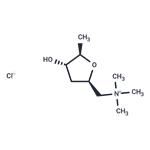
(+/-)-MUSCARINE CHLORIDE
- Product Name(+/-)-MUSCARINE CHLORIDE
- CAS2936-25-6
- CBNumberCB9427721
- MFC9H20ClNO2
- MW209.71
- MDL NumberMFCD00055067
- MOL File2936-25-6.mol
Chemical Properties
| storage temp. | room temp |
| solubility | deionized water: ≥20mg/mL |
| form | powder |
| color | white |
| Water Solubility | deionized water: ≥20mg/mL |
| FDA UNII | 7T101UWZ5W |
| UNSPSC Code | 12352200 |
| NACRES | NA.77 |
Safety
| Symbol(GHS) |

|
| Signal word | Warning |
| Hazard statements | H302-H319 |
| Precautionary statements | P264-P270-P280-P301+P312-P305+P351+P338-P337+P313 |
| Hazard Codes | Xn |
| Risk Statements | 22-36 |
| Safety Statements | 26-36 |
| RIDADR | 1544 |
| WGK Germany | 3 |
| HazardClass | 6.1(a) |
| PackingGroup | II |

